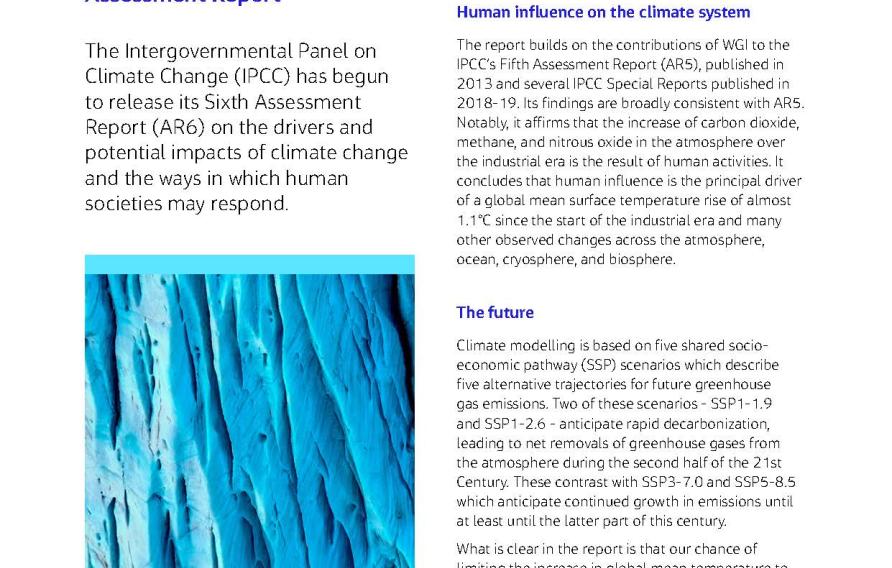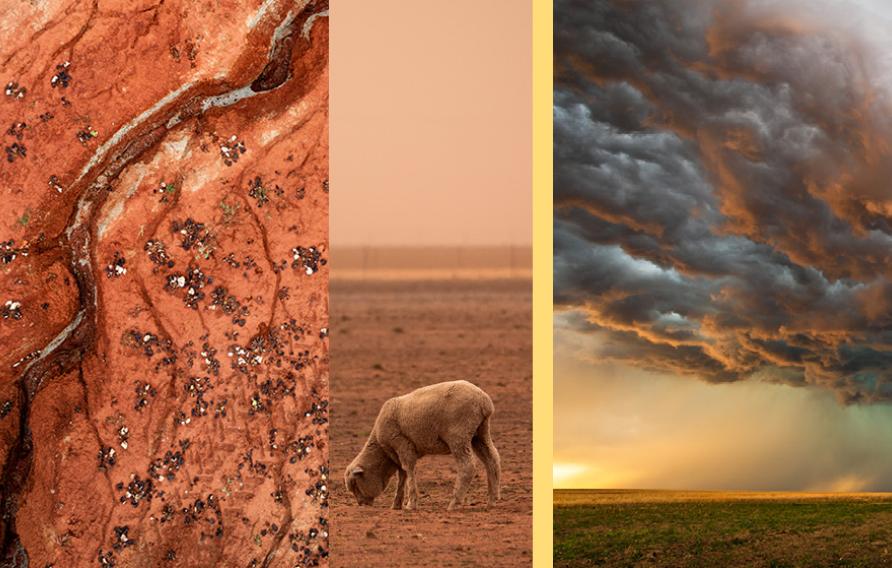
Introduction
The AR6 Synthesis Report (SYR) is IPCC’s latest report. It summarizes the current state of climate change, its widespread impacts and risks, and mitigation and adaptation actions.
Jacobs’ Global Principal, Climate Resilience Craig Clifton and Principal Technologist Water Resources & Climate Resilience Tapash Das summarize the key messages and help us understand the pace and scale of mitigation and adaptation required to deliver a more sustainable future.
Continue reading article below or download PDF for an in-depth version.
Current status and trends in climate, climate change impacts and climate action
Status and trends
In this latest report, the IPCC confirms that average global surface temperatures were 1.1 degrees Celsius (2 degrees Fahrenheit) higher across 2011-2020 than 1850-1900. It concludes that human activities—principally greenhouse gas (GHG) emissions that stem from unsustainable energy use, land use and land-use change, lifestyles and patterns of consumption and production—have caused this warming.
GHG emissions continue to grow. Average annual GHG emissions from 2010–2019 were higher than any previous decade. However, the growth rate in emissions during that decade was 40% lower than in the last decade.
Impacts and action
Global warming has had a pervasive effect on weather and climate extremes, adversely affecting food and water security, human health, economies, society and people. It has also caused substantial damages and increasingly irreversible losses across all ecosystem types.
International climate agreements, rising ambitions for climate action, growing public awareness and more affordable and accessible low-emission technologies are accelerating efforts to address climate change. However, there remains a large gap between current levels of adaptation and levels needed to reduce climate risks.
Most observed adaptation is fragmented, incremental, small-scale, sector-specific and focused on planning rather than implementation. Many adaptation initiatives also prioritize immediate and near-term climate risk reduction not transformational adaptation.
In vulnerable sectors, regions and social groups, systemic barriers such as lack of resources, insufficient community and industry engagement, lack of political commitment and a low sense of urgency, make adaptation even more challenging.
Climate change by the numbers:
-
≤ 3.6 B
The number of people living in areas highly vulnerable to climate change.
-
2040
The year by which 1.5 degrees Celsius (2.7 degrees Fahrenheit) warming is likely to be exceeded.
-
100 %
Percentage of modeled scenarios that require immediate, rapid and deep GHG reduction across all sectors to limit warming to 1.5 degrees Celsius (2.7 degrees Fahrenheit).
In the long term...
As global warming continues, every region will increasingly experience concurrent and multiple changes in climate, higher climate-related risks and greater long-term impacts.
Future emissions will drive future warming and affect all major climate system components. Many climate system changes become larger in direct relation to increasing global warming. Some changes will be irreversible on centennial to millennial time scales, particularly those affecting oceans and ice sheets.
A worst-case scenario – global warming of 4 degrees Celsius (7.2 degrees Fahrenheit) or more
Should it occur, global warming of 4 degrees Celsius (7.2 degrees Fahrenheit) or more would have far-reaching impacts. Species extinctions and biome shifts would be widespread. Approximately 10% of the global land area would face both increasing high and decreasing low extreme streamflow (the flow of water in rivers), affecting more than 2.1 billion people. Four billion people could experience water scarcity.
Sea level rise would be unavoidable for centuries to millennia due to continuing deep ocean warming and ice sheet melt. Extreme sea level events that previously occurred once per century would occur at least annually at more than half of all tide gauge locations by 2100.
In the near term...
Global warming will continue to increase until 2040, mainly due to increased cumulative carbon emissions. We will likely reach 1.5 degrees Celsius (2.7 degrees Fahrenheit) under even low GHG emission scenarios and exceed it under higher emissions scenarios. Deep, rapid and sustained mitigation and accelerated adaptation are the only ways to reduce the escalating risks to ecosystems and humans.
Hazards and associated risks at 1.5 degrees Celsius (2.7 degrees Fahrenheit) global warming
While not as extreme as global warming beyond 4 degrees Celsius (7.2 degrees Fahrenheit), the impacts of exceeding global warming of 1.5 degrees Celsius (2.7 degrees Fahrenheit) are still significant. Hot extremes on land and in water will be more frequent; rainfall, flooding, sea level rises, wildfires and permafrost degradation risks will intensify; and drinking water will become scarcer. Together these changes represent cascading risks to livelihoods, health, well-being, cultural values, food and water security and biodiversity.
Mitigation & adaptation
Mitigation pathways
Only a few of the most ambitious pathways, or scenarios, modeled by the IPCC limit global warming to 1.5 degrees Celsius (2.7 degrees Fahrenheit). Going past this limit implies increased risks and potentially irreversible impacts. To keep global warming under 1.5 degrees Celsius (2.7 degrees Fahrenheit) or even 2 degrees Celsius (3.6 degrees Fahrenheit), we must reduce human-caused carbon emissions to net zero. This requires rapid, deep and in most cases immediate, GHG emission reductions in all sectors.
Reductions can be achieved through:
- Transitioning from fossil fuels without carbon capture and storage (CCS) to low- or zero-carbon energy sources, such as renewables, or fossil fuels with CCS.
- Implementing demand-side measures and improving efficiency.
- Reducing non-carbon GHG emissions.
- Using carbon dioxide removal (CDR) measures such as afforestation, reforestation, improved forest management, agroforestry and soil carbon sequestration.
Counting the mitigation cost
Strengthening climate change mitigation entails more rapid transitions and higher up-front investments but brings benefits from avoiding climate change damages and reduced adaptation costs.
While a cost-benefit analysis that represents all climate change damages remains challenging, the global benefits of limiting warming to 2 degrees Celsius (3.6 degrees Fahrenheit) exceed the cost of mitigation, even against a wide range of assumptions. Although limiting global warming to 1.5 degrees Celsius (2.7 degrees Fahrenheit) would increase mitigation costs and create more disruption, the benefits would also be greater.
Accelerating climate responses
Time is of the essence. Adaptation options often have long implementation times and the effectiveness of many declines beyond 1.5 degrees Celsius (2.7 degrees Fahrenheit) warming. Accelerated implementation is important to close or avoid adaptation gaps. Rapid and far-reaching transitions across all sectors and systems are necessary to achieve deep emissions reductions and secure a livable and sustainable future for all.
Conclusion
There is a rapidly closing window of opportunity to secure a livable and sustainable future. Feasible, effective and low-cost options for mitigation and adaptation are available. What we require now is political commitment, well-aligned multi-level governance and institutional frameworks, laws, policies and strategies to drive transformative change and advance climate resilient development.
You might be interested in...
-
 Report
ReportUnderstanding the IPCC Sixth Assessment Report Key Findings
The latest IPCC report outlines the sheer scale of the challenge we have before us in reducing greenhouse gas emissions and mitigating the worst effects of climate change on people and the planet. Catch up on the key findings.
-
 News
NewsUnderstanding the IPCC Sixth Assessment Report - Working Group II Report
Climate Change 2022: Impacts, adaptation and vulnerability












































